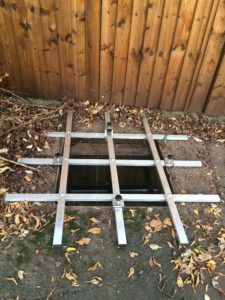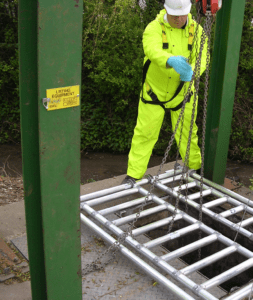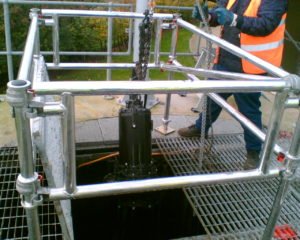SHP speaks to Paul Turpin, Health, Safety & Wellbeing Adviser at Thames Water, to understand how a fall from height can also happen at ground level and how, in the water industry, the risk of ‘falling into’ is as great as ‘falling off’.

Paul Turpin
“I’ve worked in the water industry for almost twenty years. Firstly on the tools then later as a health and safety professional.
“It’s fair to say that prior to entering the water industry I had very little concept of ‘work at height’. That was soon to change. Within weeks of taking up my post I would regularly lift pumps from very deep wells to unblock them and perform other maintenance tasks. We would use lifting equipment consisting of a block and tackle attached to a portable lifting davit. One of the first pieces of safety equipment I learned to use was a portable grid that we would place over the opening of the well once we had removed the covers. The grid had doors that opened as we lifted the pump from the well, it’s purpose being to allow the pump to be lifted from the well but also, to prevent us from falling into what could be a very deep void. Many water companies now specify the fitment of well covers with integral fall protection grids, but the industry has a lot of older sites and assets so I can see us using the portable grids for the foreseeable future. To me using the grid’s became second nature and my job taught me the important concept that you can get just as badly hurt falling ‘into’ as you can falling ‘from’.

“During the ensuing years I’ve seen many innovations as safety equipment supplier’s line up to help the water industry in its quest not to fall ‘into’ things. Concertina grids that open like a trellis so they can be placed over manholes, work restraint systems that allow workers to work near to the edge of a void but prevent them from falling into it, portable barrier systems that can be assembled at site. At Thames Water we would rather send a drone ‘into’ something than a person if that is at all possible. Commercial drones are expensive but they are replaceable, people are not. We recently sent a drone into a sewer, and have been using them to inspect lifting equipment such as overhead cranes. With the huge advances in robotics maybe it’s only a matter of time before we have lots of robots working at height while being controlled by the employee from a place of safety.
“The Water industry is extremely complex with regards to working at height with our wells, tanks, manholes, troughs, lagoons, pits and trenches the concept of falling ‘into’ as opposed to falling ‘off’ is where we concentrate our energy and effort towards education and standards setting.”
Training
“At Thames Water we look at how we train, the equipment we use, our working practices and continue to challenge ourselves each year through asking are we doing enough? A good example is the use of the pump lifting grid. Twenty years ago it was a great piece of kit and, in my opinion, it still is. Unless there was a pump passing through the grid meaning the doors were open, workers were fully protected from a fall. But, rightly so, we are now asking “how do we continue to protect workers for the few seconds it takes for the pump to pass through the open doors and the doors to close?” We are currently looking at everything from fixed and portable hand-railing systems right through to our use of work positioning lanyards. Do these systems provide the right level of protection and do they protect the worker for the entire time that they are exposed to the risk of a fall?
“I’m sure the water industry and its suppliers will continue to innovate and make work at height safer, but also we need to constantly remind ourselves of the basics.”
Basic rules

“For me, the most fundamental thing we can remember in the water industry (and any other industry that works at height) is the most important part of the work at height regulations. Those three basic rules that, if followed every time, mean you can’t really get it wrong:
- AVOID work at height where it is reasonably practicable to do so.
- If you cannot avoid working at height, implement measures to PREVENT a fall.
- If you cannot avoid working at height, and you cannot implement measures to prevent a fall, take sufficient measures to MINIMISE the distance and/or consequences of a fall.
“This means we need to get our designers fully engaged and design out the need to work at height wherever possible. When we build and refurbish our sites we need to specify permanent, fixed measures that give collective protection over portable measures that might only protect the person using them. And if we get to the point where we are seriously considering option three, we need to return to options one & two and try again.
“Training is also key, but before we start technical training on pieces of work at height equipment we need to ingrain the basics. And that begins with recognition. Fall from height incidents are prevented in the water industry every day because we recognise working at height and apply these principles.
“If we train our people to the point where they easily recognise work at height, have a fundamental understanding of those work at height principles (AVOID, PREVENT, MINIMISE) and then fully support our people’s right to refuse to work at height if they can’t follow one of the three, we can’t go far wrong.”
Challenges

“At Thames Water safe working at height is one of many challenges we face every day. In a multi-faceted business with its diverse risk portfolio our ability to innovate, constantly improve and challenge ourselves and others has to be second to none and our pursuit of safety, health and wellbeing relentless. We have had an 80% reduction in injuries in the past 5 years. Our challenges of unsafe acts or conditions have increased by over 600% in the same period. Work at height tends to make up 3%-4% of our incidents, near miss reports and safety observations so one of our main challenges is to make sure that the 80% reduction in injuries and 600% increase in challenges of unsafe acts or conditions is replicated in the high risk area of work at height.
“We have a Health & Safety Leadership Team (HSLT) made up of senior executives from Thames Water and its supply chain whose role is to challenge and improve the health and safety performance of all partners within our business. The HSLT regularly challenges the status-quo by introducing initiatives such as the Thames Water Essential Standards, a series of safety, health and wellbeing standards that are a contractual obligation for all of our partners to work to. These Essential Standards are not just about legal compliance, they represent the very best of innovation and best practice. We are currently working on an Essential Standard for work at height that we hope to issue to the business very soon.
“So, in summary, that’s what we at Thames Water are doing. We will let you know how we get on.”
Why should you subscribe to the SHP newsletter?
Do you want the very latest health and safety news, product launches, job listings and expert opinions sent straight to your inbox daily?
The SHP newsletter is essential reading – sign up today to get your hands on all this!





